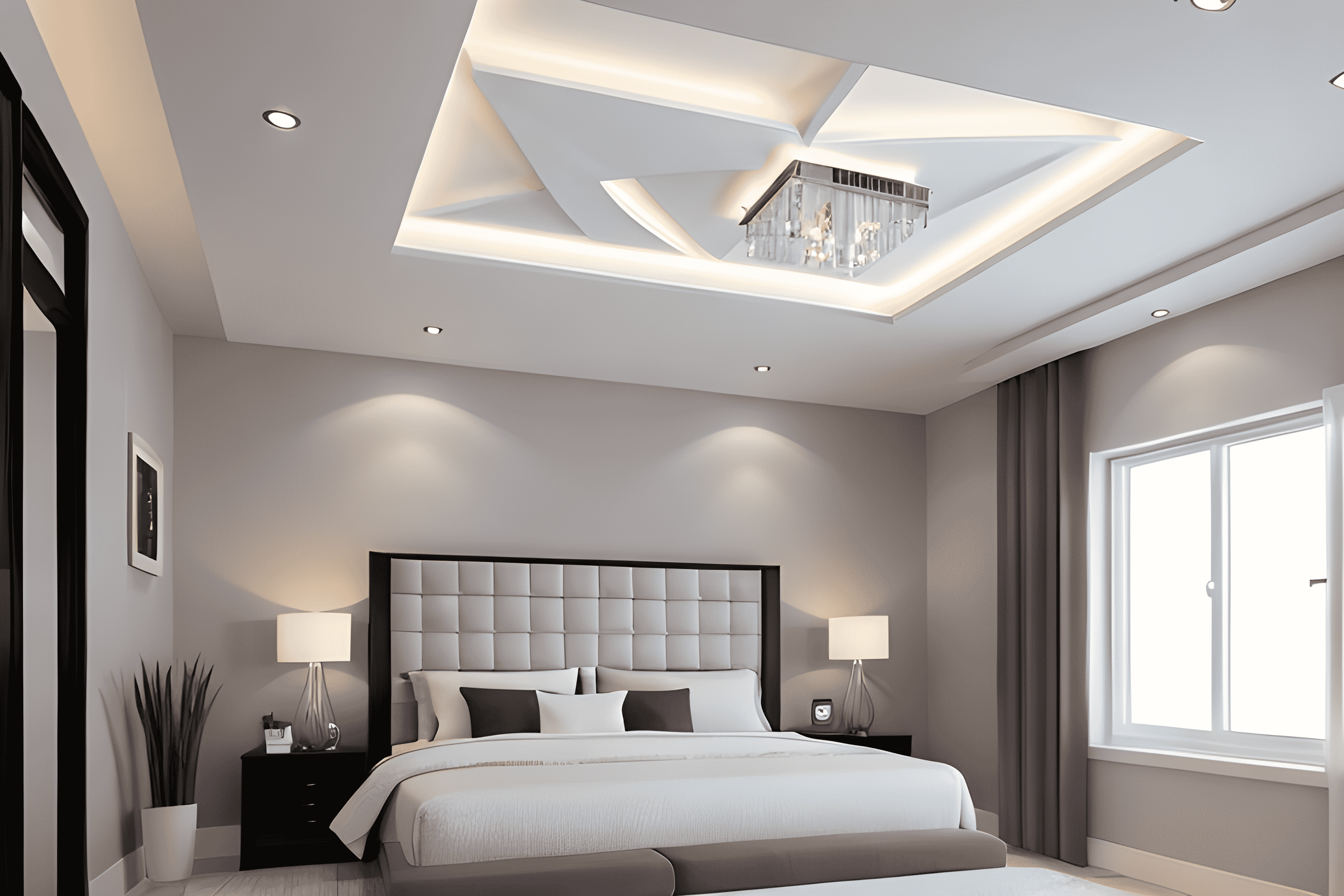Alternatives to Traditional False Ceilings
Are you tired of the same old traditional false ceilings? Look no further than these unconventional alternatives that can transform any room into a work of art. From natural elements to creative approaches, we have compiled a guide for you to explore and enhance your ceiling design options.
Introduction
False ceilings, also known as dropped or suspended ceilings, are secondary ceilings that hang below the main ceiling. They are commonly used to conceal electrical wiring, ductwork, or plumbing pipes. While traditional false ceilings can serve a practical purpose, they can also make a room feel plain and uninspired. That’s where these unconventional alternatives come in.
Definition of Traditional False Ceilings
Traditional false ceilings are typically made of gypsum, a type of plaster, or acoustical tiles. They are installed with metal frames and hung by wires from the main ceiling surface. These ceilings are plain and lack character. They can also be difficult to maintain and repair over time.
Why Consider Alternative Options
Unconventional alternatives to traditional false ceilings offer a unique way to add style and character to a room. They are customizable and can be used to create a wide variety of designs and patterns. They can also be environmentally friendly and sustainable, making them a great option for those who want to reduce their carbon footprint.
Benefits of Unconventional Alternatives
Unconventional alternatives to traditional false ceilings offer several benefits:
- Adds character and style to a room
- Customizable designs and patterns
- Can be environmentally friendly
- Can be cost-effective
Now, let’s explore some unconventional alternatives to traditional false ceilings.

Chapter 1: Natural Elements
1.1: Wooden Ceiling
A wooden ceiling is an excellent way to add warmth and natural beauty to a room. Types of wood to use include cedar, mahogany, and teak. Designs can range from simple to intricate patterns that can transform a room. Benefits of using wood include its durability, natural insulation, and resistance to moisture and termites.
1.2: Bamboo Ceiling
Bamboo is another natural element that makes an excellent ceiling option. Types of bamboo to use include woven bamboo mats or glued bamboo strips. Designs can range from simple to complex patterns, and the benefits of using bamboo include its sustainable properties, lightweight, and natural beauty.
Chapter 2: Decorative Elements
2.1: Fabric Ceiling
A fabric ceiling adds a touch of elegance to any room. Types of fabric to use include silk, velvet, or cotton. Designs can range from plain to patterned, and you can add texture and dimension with ruffles or pleats. Benefits of using fabric include its versatility, easy installation, and sound absorption properties.
2.2: Stencil Ceiling
A stencil ceiling is a fun and creative way to add patterns and designs to a room. Types of stencil patterns to use include geometric shapes, florals, or intricate designs. Benefits of using stencil patterns include its ability to add a personalized touch to any room, its subtle but striking effect, and its low cost.
Chapter 3: Industrial Materials
3.1: Metal Ceiling
A metal ceiling can add an industrial and modern touch to any room. Types of metal materials to use include aluminum, tin, or copper. Designs can range from a subtle sheen to a metallic pattern. Benefits of using metal include its durability, ease of maintenance, and its ability to add texture and depth to a room.
3.2: Concrete Ceiling
A concrete ceiling can add an urban and edgy vibe to any room. Types of concrete to use include polished, textured, or painted. Designs can range from simple to intricate patterns. Benefits of using concrete include its strength, durability, and its ability to regulate the temperature and humidity in a room.
Chapter 4: Creative Approaches
4.1: Lighting Effects Ceiling
A lighting effects ceiling can add ambiance and mood to a room. Types of lighting effects to use include spotlights, LED strips, or fiber optic stars. Designs can range from a starry sky to a color-changing light show. Benefits of using lighting effects include its ability to add flair and excitement to any room, its energy efficiency, and its cost-effectiveness.
4.2: Wall Art Ceiling
A wall art ceiling can add personality and creativity to a room. Types of wall art designs to use include murals, portraits, or abstract designs. Designs can range from a single image to a series of images that flow together. Benefits of using wall art include its artistic potential, its ability to make a statement, and its versatility.
4.3: 3D Ceiling
A 3D ceiling can add a realistic and immersive effect to any room. Types of 3D designs to use include sculptured, molded, or embossed. Designs can range from a realistic sky view to a geometric pattern. Benefits of using 3D designs include its ability to add depth and dimension to any room, its creative potential, and its uniqueness.
Chapter 5: DIY Ceiling Ideas
5.1: Fabric Pasted Ceiling
A fabric pasted ceiling is a great DIY option that can be easily done by anyone. Steps to achieve the design include selecting a fabric, applying a starch-based adhesive, then smoothing. Materials needed include fabric, starch-based adhesive, and a smoothing tool. Benefits of a fabric pasted ceiling include its low cost, its ease of installation, and its versatility.
5.2: Paper Mache Ceiling
A paper mache ceiling is another fun DIY option that can be done with simple household items. Steps to achieve the design include creating a paper mache mixture, layering it onto the ceiling, then painting. Materials needed include paper, flour, water, paint, and brushes. Benefits of a paper mache ceiling include its low cost, its ease of installation, and its potential for creativity.
Chapter 6: Cost Comparison and Sustainability
6.1: Cost Comparison
Unconventional alternatives to traditional false ceilings can be cost-effective in the long run. While the initial investment may be higher, the durability and longevity of unconventional alternatives can outweigh the cost of traditional false ceilings. Factors to consider when choosing an alternative ceiling include its installation costs, maintenance costs, and lifespan.
6.2: Sustainability
Unconventional alternatives to traditional false ceilings can also be environmentally friendly and sustainable. Factors to consider when choosing a sustainable option include its material source, production process, and end-of-life disposal. Benefits of choosing a sustainable option include its eco-friendliness, its potential to reduce your carbon footprint, and its ability to promote sustainability.
Conclusion
Unconventional alternatives to traditional false ceilings can add style, character, and creativity to any room. Whether you choose natural elements, industrial materials, or creative approaches, there is an unconventional alternative for every taste and style. Consider the cost and sustainability when making a decision on your alternative ceiling option, and enjoy the unique and personalized beauty it adds to your home.
Frequently Asked Questions
1. What is a false ceiling?
A false ceiling, also known as a suspended or dropped ceiling, is a secondary ceiling that hangs below the main ceiling surface.
2. What are the benefits of using unconventional alternatives to traditional false ceilings?
Unconventional alternatives offer customizable and unique designs, potential eco-friendliness, and cost-effectiveness in the long run.
3. What materials can I use for unconventional alternatives?
Materials range from natural elements such as wood and bamboo to industrial materials like metal and concrete. You can also explore creative approaches like lighting effects, wall art, and 3D designs.
4. Are unconventional alternatives more expensive than traditional false ceilings?
While the initial investment may be higher, the durability and longevity of unconventional alternatives can outweigh the cost of traditional false ceilings in the long run.
5. Is it possible to install unconventional alternatives as an addition to traditional false ceilings?
It is possible to add unconventional alternatives on top of traditional false ceilings to add personality and character to a room. However, it is important to consider the weight and installation requirements of installing multiple layers of ceilings.










